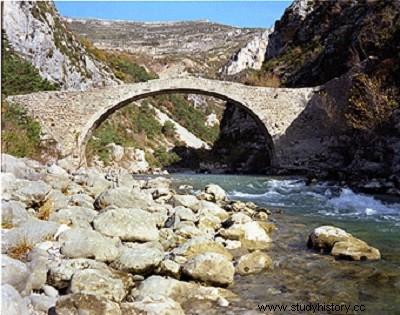
In order to avoid detours as much as possible, the Roman engineers had developed a set of facilities for crossing the waterways.
Fords
The tracks often forded these. These areas were often simply paved or made of stone masonry with lime, supported by wooden beams. However, the excavations have brought to light fords of great importance, made of interlocking blocks of large apparatus with a retaining wall, a depression channeling the water and a causeway for the passage. These fords sometimes evolve into wooden or stone bridges.
Bridges
Stone bridges
The most spectacular arrangement of Roman roads was the construction of stone bridges over medium-width waterways. They allowed the continuity of traffic in all circumstances, for example during periods of flooding. These works have often survived the centuries and are still used today or, after their destruction, their foundations were used for later constructions. Beyond the road aspect, bridges have always been sources of settlement.
Depending on the width to be crossed, the bridges could have an isolated arch or count several arches. In the latter case, the piers could be protected by rear and forepeaks, preventing, during floods, floating objects from piling up against the piers and the bridge forming a dam that would have endangered its solidity. To also limit the water pressure during steep climbs, rectangular indentations could be made there.
Former mixed stone + frame bridge in Trier:the piers are authentically Roman.
Wooden bridges
Stone bridges were generally reserved for major axes, near large cities. Most of the bridges were made entirely of wood, founded on pilings.
Composite bridges
Or, for added strength, the piers were made of stone, but the bridge deck was framed with timber.
The Trèves bridge was one of those mixed bridges with masonry piers and wooden deck. Today, the Roman piles are preserved, but the apron, more recent, is in cut stone.
Boat decks
For the crossing of the widest rivers, the Romans had designed bridges of pontoon boats with, on each bank, a hard part which was attached to it, as well as piles for anchoring in the river. even, allowing a better stabilization of the whole (See:Arles, Cologne).
Bins
The system of paid ferries, responsible for transporting passengers and goods from one bank to the other, was also widely used.
